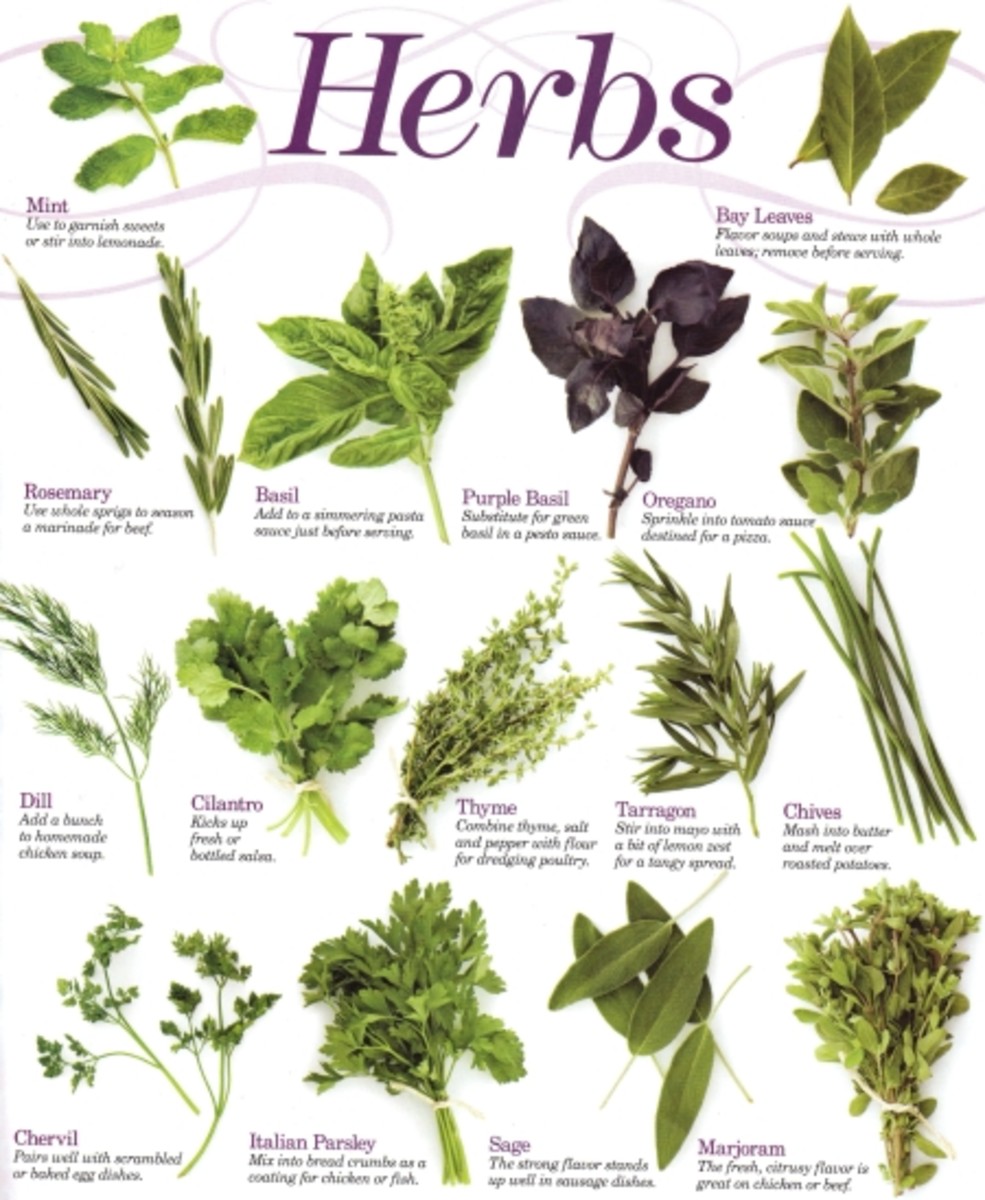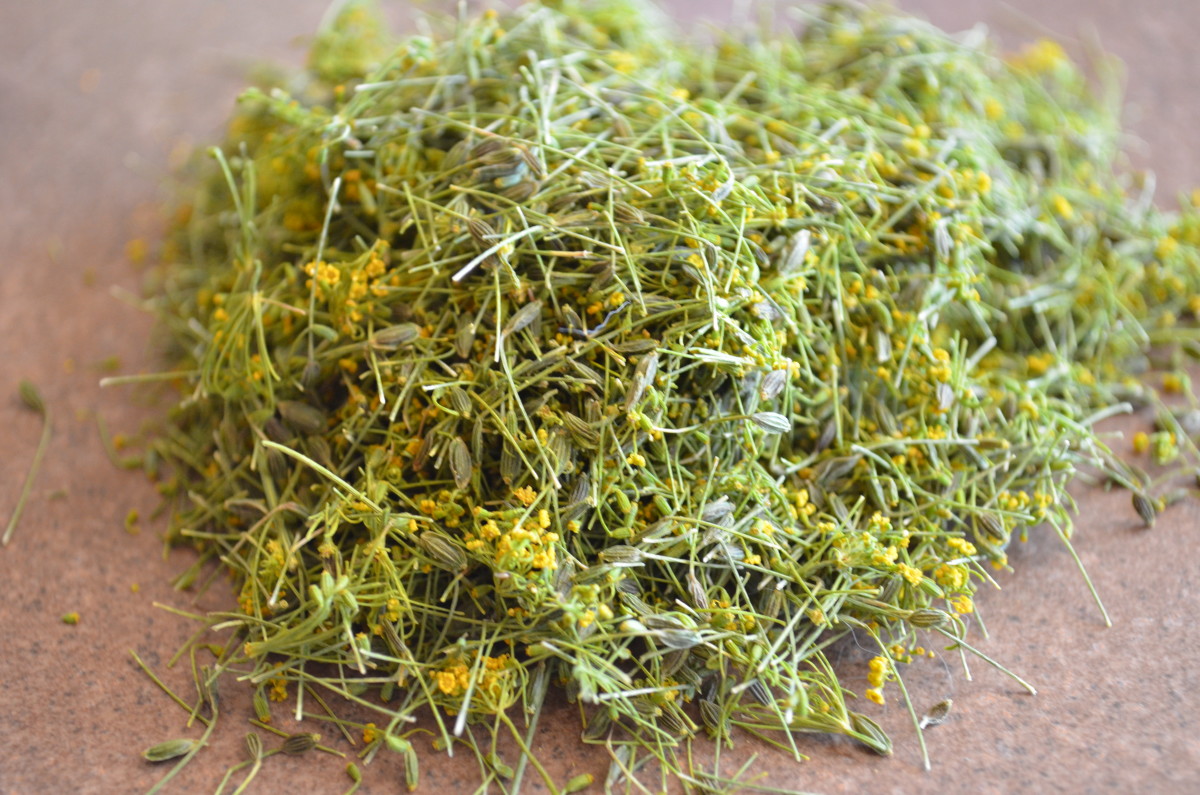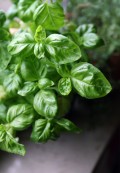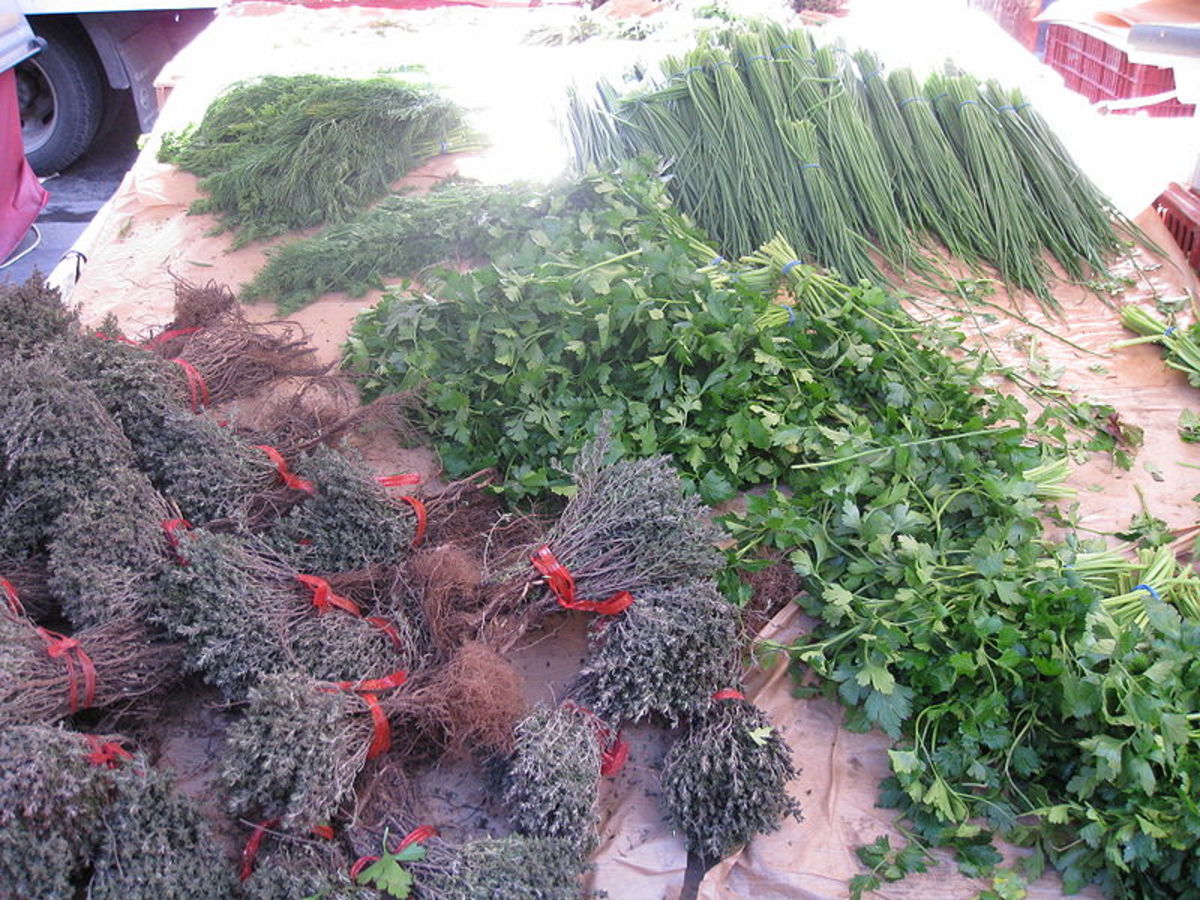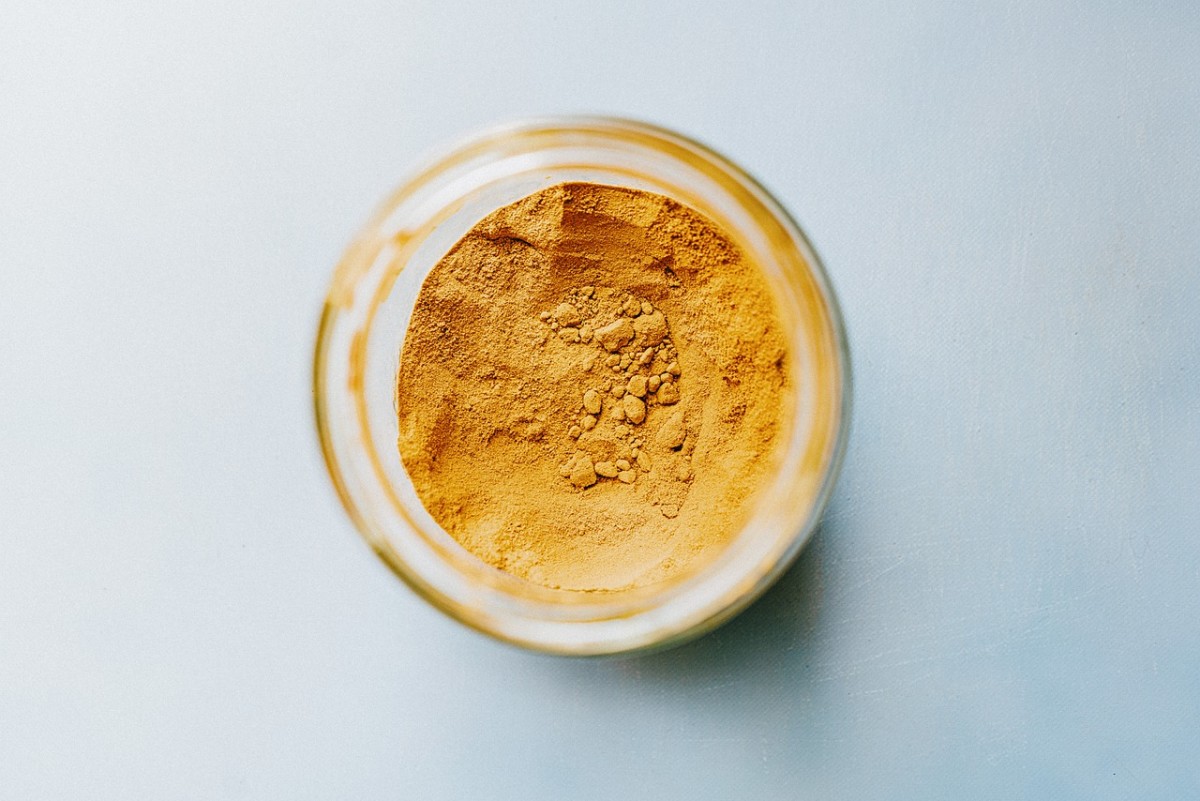- HubPages»
- Food and Cooking»
- Cooking Ingredients»
- Herbs & Spices
Everything You Ever Wanted to Know About Basil

What is Basil?
Hailed as the most useful culinary herb on the seven continents, basil is one of the most popular esculent herbs in the world. Unlike many other herbs, basil boasts approximately 60 to 70 different varieties, which produce an abundance of succulent tastes to satisfy even the most discerning palate. No two are exactly alike.
As a member of the mint family, basil resembles its cousins in appearance, but that’s where the similarities end. Looks can be deceiving. Sweet basil, which is used most often, looks like mint, but its aroma and taste are entirely its own. Aromatically pungent, the herb emits a slightly sweet taste (hence its name) that complements a vast number of ethnic dishes and is a staple component in both Italian and Greek cuisine.
Integral in flavoring tomato-based sauces, basil can also be utilized as an addition to meat (beef and chicken), seafood, salads, and a variety of egg dishes. Moreover, basil serves to do far more than enhance the flavor of your favorite foods, it also helps aid digestion.
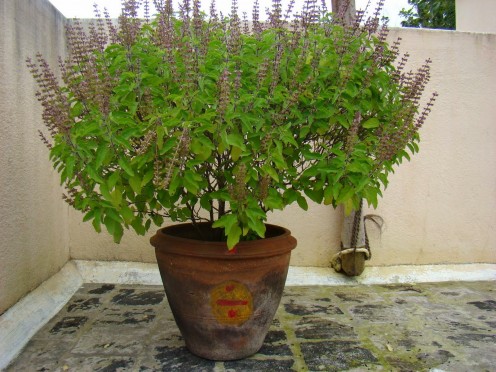
Origin and Early History of Basil
Revered as sacred in its native country of India, where it was originally known as the “tulsi” plant, basil is embraced as a mighty protector by its people. Its botanical name, Ocimum basilicum, is derived from the Greek term basilikohn, which means royal, an attribute that supports its venerated place in Indian culture.
The “tulsi” plant is an important symbol in the Hindu religion. Families most often cultivate the plant in specially designed structures or shrines for times of worship, but it can also be found potted on verandas and growing in gardens. Its leaves are considered a vital element in all Hindu ceremonies, a fact not overlooked by magistrates who required Hindu witnesses to swear on the plant in court during the period of British colonization. The Hindus, who worship basil as a holy herb, also value the plant for its medicinal benefits, and hail it as a remedy for a variety of ailments.
Historically, basil was an important ingredient in embalming the dead, particularly in Egypt where it was utilized in the mummification of bodies and valued for its preservation properties. The people of ancient Greece and Rome associated the plant with poverty, abuse, and hatred. This association may have arisen from their belief that the plant attracted scorpions. Cretans, however, viewed the plant’s presence on the windowsills around their homes as protectant against evil spirits.
Medieval Times
During the late medieval period, basil began sporadically appearing around the countries of Europe, accompanied by strangely conflicting opinions of the herb’s uses. In some places, it was deemed poisonous, while in others, it was heralded as a miracle treatment for low spirits and clouded thoughts.
Symbolically, there seems to have been a bit of confusion as well. In Ancient Rome, the herb, as already mentioned, was a symbol of hatred, later contradicted by the beautiful young Italian girls who twined the herb in the braids of their hair to announce their availability. Romanian custom, however, leaves no doubt as to the romantic allusions of a blooming sprig. To accept such an offering symbolized a contract between the young lady who offered it and the lucky young man who accepted. Love was swiftly followed by marriage.
Medieval housewives and servants utilized basil’s aromatic properties as a strewing herb to freshen floor rushes. Its pungent, sweet scent carries subtle nuances of mint and anise, something that made it a popular ingredient in sachets, which were created to refresh linens and blankets in medieval homes. According to Thomas Tusser’s Five Hundred Points of Husbandry, dried herbs and powders were prepared and combined before sewing them into linen and storing them among linens and fine clothing.
“Take thee orris root, red rose petals, marjoram, and sweet basil, of each ounce, yellow sanders, cloves and musk. Bruise the herbs and spices between the fingers to release the scent. Close up the sweet bags and tuck them in the linens and clothes.”
Modern day English might just make this medieval preparation a reality, so I did some homework in order to understand exactly what ingredients are called for.
Aromatic Sachet
- 2 T. 2 T. Orris Root, root stock of an iris
- 2 T. Dried Rose Petals
- 2 T. Dried Marjoram2
- 2 T. Dried Sweet Basil
- 2 T. Yellow Sanders, leaves from a mountain plum tree, which grows in tropical climates
- 2 T. Musk, Musk Powder
Medicinal Properties
Medicinally, basil has long been respected for its potential to heal, clear the mind, and unlock the heart. Fortunately for us, as time goes by, more and more of the old tales are found to be true.
Proponents of natural remedies recommend basil for its antispasmodic properties, which have been proven to settle upset stomachs and relieve gas. Its pungent flavor kick-starts the production of saliva, and thus enables our bodies to properly digest our food. These same properties are also said to be effective in the treatment of motion sickness.

Basil Wine
Basil wine is easy to prepare and has long been esteemed as a natural way to improve digestion when served as an after dinner drink. Not to mention, it’s delicious.
Basil Wine
1 bottle white wine (your preference)
2 ounces fresh basil bound
Warm wine on stove-top and remove from heat. Steep fresh basil in wine for twenty-four hours, strain, and refrigerate. Note, fresh basil may be replaced with a dried basil sachet.
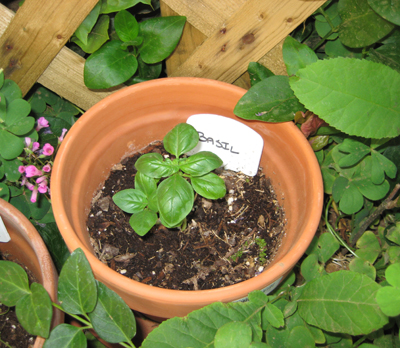
Basil: To Buy or to Grow?
Today, basil grows in many regions throughout the world and is available at our local grocers and spice specialty stores. Better yet, basil is a hearty plant and can easily be grown right in our own homes. Plugs can be purchased at your local nursery for a nominal fee, although starting your plant from seeds is a popular choice for many. Parents of young children might find the prospect of indoor gardening with their children an adventure … I know I did.
Basil is a vigorous plant, and there are numerous varieties from which to choose. Lucky for us, cultivation is the same for each. The most popular types of basil are lemon, red, anise, and cinnamon. A less known variety, Dwarf Basil, is a favorite of fine chefs, who treasure it for its clean, pleasant aroma and fine taste.
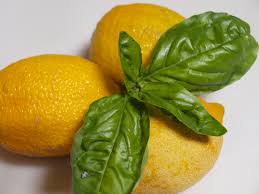
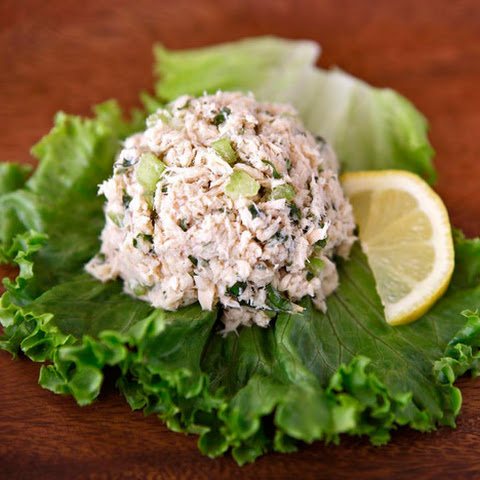
Lemon Basil
Lemon basil has a distinct aroma and mild taste, which is particularly complementary to grilled fish entrees, as well as shrimp, scallops, and crab. It also pairs well with chilled salads of all kinds, especially my favorite … tuna fish salad.
Lemon Basil Tuna Fish Salad
1 Large can of tuna fish (packed in water)
1/4 cup mayonnaise (olive oil based)
1/4 tsp. salt
3/4 tsp. minced garlic
2 tbsp. freshly minced lemon basil leaves
Juice from 1/2 lemon
Instructions: Drain tuna, mix all ingredients thoroughly.
Sweet Basil
Of all types, Sweet Basil is hands down the most commonly sown basil in kitchen gardens, but admittedly, I am partial to the unique taste of lemon and the lemon variation. Adequate drainage is imperative when growing this herb, so purchase your pots accordingly and be sure to line the bottom with stones or gravel. This will help to ensure elimination of water overflow. Note, the plant itself will serve as more than an attractive source of nourishment, it will also help purify the air in your home and act as a repellent to the flies and mosquitoes that shun rather than appreciate its scent.
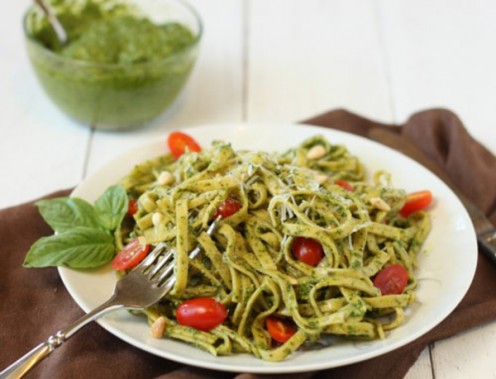
Purchasing Basil
For those of you who prefer to purchase basil, both fresh and dried versions are available in most any local supermarket. Choosing fresh leaves will always afford you superior quality and taste, and like any produce, opt for organic whenever possible. Leaves should be free of blemish and dark green in color, with no visible yellowing. Fresh leaves can be stored in the refrigerator. Simply wrap the leaves in paper towels and place in an airtight container. Adding a bit of olive oil will keep your leaves crisp and ready to use for up to fourteen days.
If you find you have more than you need, freezing is also an option. Simply puree the leaves in a blender or food processor, add a touch of olive oil (this will keep the color from turning), and place preparation in an ice-cube tray. After freezing, pop out the cubes and store them in a zip-lock bag.
This choice of preserving also applies to pesto, as you can prepare and freeze your favorite recipe in much the same way. Thus, it only makes sense to increase the ingredients and save time in the future. Pesto is not only tasty … it’s nutritious and versatile to boot. It makes pasta, rice, and pizza come alive, whereas ordinary sandwiches become special and soups acquire added zest. Then there’s my favorite ... a large dollop of pesto slathered over a perfectly grilled steak, straight off the grill. It doesn’t get better than that.
Pesto
1/3 cup pine nuts
2 ounces freshly chopped basil leaves
2 large cloves of peeled garlic
8 tbsp. olive oil
1/2 cup finely grated Roman cheese
1/3 cup finely grated Parmesan cheese
- 1. Toast pine nuts until golden brown in an ungreased skillet and cool.
- 2. Place cooled pine-nuts, basil, olive oil, and garlic in food processor or blender and puree until smooth and creamy.
- 3. Stir in Romano and Parmesan, salt and pepper to taste, and serve.
To freeze, place measured increments (2-3 tbsp. depending) into ice-cube trays, drizzle with olive oil, and freeze. After freezing, store pesto cubes in an airtight container. Note, for pesto, I prefer freezing the finished product in individual mason jars, which can be purchased in a number of different sizes according to personal preference.
Dried Basil
Although many people like their herbs to be as fresh as possible, basil is just as popular in dried form. I’ve never known my mother to use anything other than dried herbs, and I followed in her footsteps for years. There’s no doubt that the expansion of supermarkets and prevalence of farmer’s markets in our modern day world has changed the way we buy and store our favorite foods. None-the-less, many people continue to use their herbs a “pinch” at a time, and let’s face it, dried herbs not only outlast their fresh counterparts, they’re also easy on the budget.
Those of you with green thumbs can dry your own basil straight from garden. Basil can be air dried, but since it has a higher water content than many other herbs, experienced gardeners claim that using a dehydrator works best. Dried herbs, whether pre-packaged or home dried, should always be stored out of the light and kept at room temperature to prevent loss of flavor. Shelf life is estimated at about twelve months.

As already mentioned, basil is an integral ingredient in tomato-based dishes. Thus, canning tomatoes in season will enable you to have a well-stocked supply of tomato base for use in various red sauces, soups, and salads throughout the year. An added incentive would be the time canning saves you in the long run, in addition to the money it saves buying more costly, inferior tomatoes for the same purposes out of season. To make your own base, follow the easy to use instructions below.
Basil, Garlic, and Onion Tomato Base
10 pounds medium sized tomatoes
2/3 cup chopped onion (sweet)
4 garlic cloves (minced)
2 tsp olive oil
3 tbsp. freshly minced basil
1/2 lemon (juiced)
1) Wash, core, and slice tomatoes (set aside)
2) Saute garlic and onion in olive oil, add tomatoes, and bring to a boil. Turn down heat and simmer on low for 30 minutes (stirring constantly)
3) Squeeze fresh lemon juice into the bottom of each canning jar and ladle sauce on top (leave one inch between the top of your sauce and the lid)
4) Cover your jars with bands and lids and place into boiling water for forty minutes. (16 ounce jars are recommended for red sauces, 8 ounce jars are perfect for a base intended as a starter for soups and stews)
Note- There are a number of different water canners available for purchase if you find canning is something you enjoy.
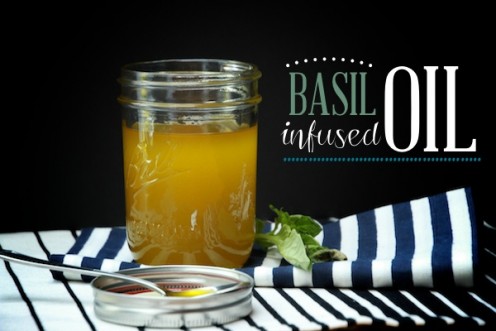
Basil, Beauty and Aromatherapy
Outside of the kitchen, basil can often be found in various beauty products. Commonly included in the ingredients of blemish treatment creams, it is also said to facilitate the lightening of dark spots brought on by age. Basil oil, on the other hand, is reputed to relieve dandruff and promote healthy, shiny hair. Shampoos containing basil extract are readily available in most local stores.
As an essential oil, basil’s spicy aroma is credited with the ability to soothe and refresh tired minds and bodies, all while facilitating a state of increased concentration. Add a small amount of essential oil to a pot of boiling water and enjoy the aroma as it fills your home.
When we consider all the benefits basil has to offer, it's easy to understand how some culinary experts have deemed basil “king of the herbs.” Basil is definitely somewhere at the top.



